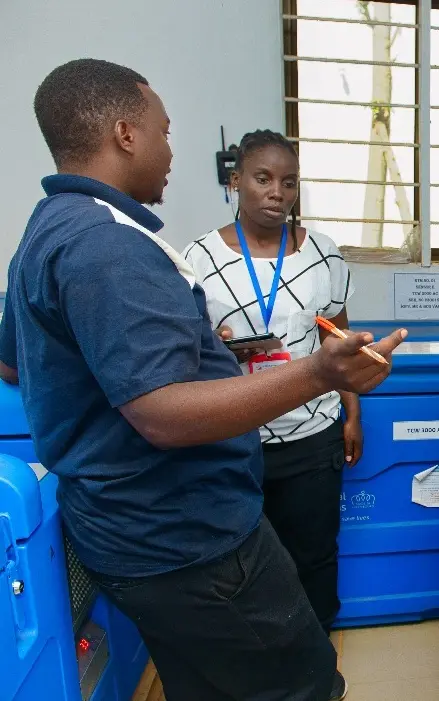Findings from the Rapid Response & Repair Baseline Assessments
Nexleaf’s Rapid Response & Repair (R3) initiative, funded by Gavi and designed in collaboration with the governments of Malawi, Rwanda, and Tanzania, seeks to improve vaccine cold chain equipment performance through digital transformation.
R3 identifies country-specific pathways to ensure national vaccine systems achieve the improvements that automated cold chain data makes possible. These include building digital tools for CCE management on country-owned platforms, implementing designated funding mechanisms to rapidly repair failing equipment, and testing on-demand remote training for biomedical engineers.

From August through October 2025, Nexleaf Analytics, together with Ministries of Health and local organizations in Malawi, Rwanda, and Tanzania, conducted a baseline assessment of vaccine cold chain performance in each country. In addition to assessing cold chain equipment (CCE) performance, we also sought to investigate the usage of remote temperature monitoring devices (RTMDs). The goal was to answer the following questions:
- What is the current status of CCE performance, RTMDs, and overall immunization services in the target regions?
- How are CCEs and RTMDs managed and maintained? What protocols, policies, practices, and budget mechanisms support equipment operations and repairs?
- How is RTM data collected, analyzed, and applied to inform maintenance and repair decisions that improve CCE performance?
Collaborators used a mixed-methods approach to gauge the scope and scale of specific challenges and obstacles faced by frontline health workers and local health facilities. Baseline assessment data is now guiding efforts to strengthen equipment maintenance and reliability, ultimately safeguarding vaccine delivery across all three health systems.
Together, these findings reveal a cold chain that functions on paper but breaks under operational stress, and offer insights as to why many digital investments have stalled or fallen short in practice.
Here are 6 cross-cutting insights from our assessment:
A Functional but Fragile Cold Chain – High national averages of CCE performance often mask disparities in CCE performance at sub-national levels. Some last mile health facilities experience equipment failure at 3x the rate of larger regional vaccine stores.
RTM Data is Underutilized – Countries have made progress to increase the coverage of health facilities with RTMDs to monitor CCE performance. However, there is often a blind spot at last mile clinics, where health workers are least likely to review RTM data.
Untraceable Maintenance – Health workers describe an existing CCE maintenance system, but it is largely informal and undocumented, undermining transparency and accountability. For instance, health workers report performing preventive maintenance, but no documentation exists to affirm date or location – even on paper.
Confidence without Capacity – Healthworkers have high confidence in their ability to repair & maintain CCE, but self-reported health worker capacity does not correlate with equipment performance. This suggests that healthworkers tasked with CCE management are constrained by systemic barriers, and confirms that they need more support and better tools.
CCE Maintenance Budgets: A Mixed Bag – There is an absence of predictable and adequate funding for CCE maintenance and repair within government budgets, creating critical bottlenecks that directly delay repairs by leaving essential costs unfunded. Even when governments do fund maintenance and repairs, approvals can take weeks or even months, and disbursed funds often fail to cover the true costs associated with maintaining CCE functionality.
Heroes Hold it Together – Frontline health workers and technicians routinely pay for repairs out of their own pockets, often without reimbursement, resulting in a hidden financial penalty for health workers. Despite implementing creative workarounds to prevent vaccine spoilage when CCEs fail, there is an undue burden on health workers to take extraordinary measures and ensure vaccines remain potent and patient services are uninterrupted.
Here’s the good news: Results from this baseline assessment align strongly with the global- and country-specific R3 prototypes currently being implemented. This evidence also supports the overall R3 approach to improving CCE maintenance and repair through holistic, country-led digital transformation of vaccine cold chain management.
Without fixing the operating conditions around CCE, including budgets, data use, workflows, and accountability, any digital tool or equipment investment will stall. R3 shows a path to ensuring these healthcare infrastructure investments actually deliver reliability.
The ultimate purpose of R3 is to leverage data to help countries shift from an ad-hoc approach to cold chain maintenance to predictable system performance: the real objective of digital transformation.
Endline data collection activities to assess the impact of the R3 prototypes currently being implemented will be conducted in early April 2026. We look forward to sharing and disseminating the evaluation results by the middle of next year.
Thank you to our subcontractors: Clinical Research Education and Management Services (CREAMS) in Malawi, Vanguard Economics in Rwanda, and CREMES International in Tanzania for conducting the R3 baseline assessment activities in their respective countries.